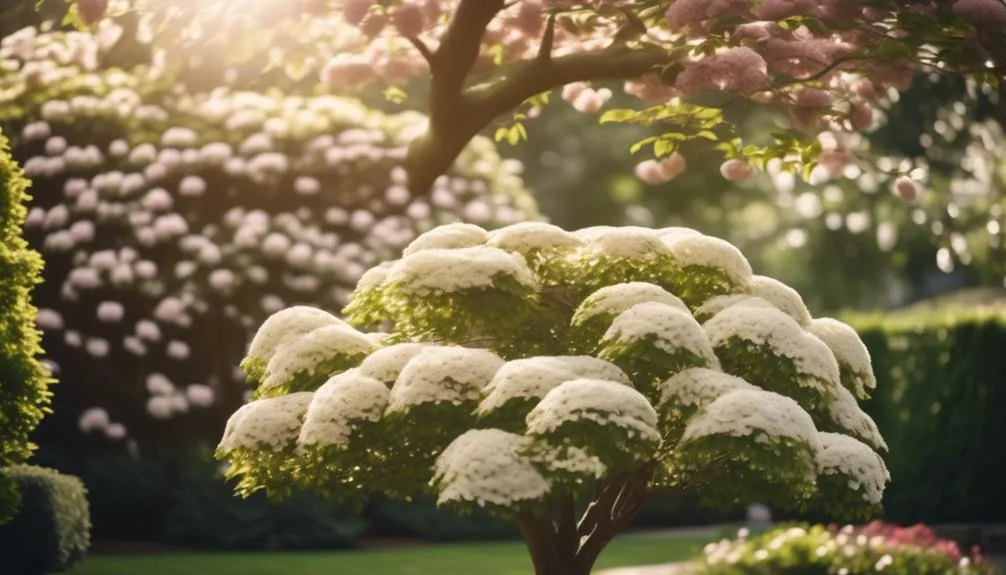Choosing the right spot to plant dogwood trees is essential for their beauty and health. Factors like sunlight, soil, and surrounding landscape all impact the tree's appearance. But where should you plant your dogwood tree for the best look?
Let's look at the key considerations to help you decide. Just like finding the perfect frame for a painting, the location of your dogwood tree is crucial for its overall appeal.
Sunlight Requirements
To ensure the healthy growth of your dogwood trees, it's essential to select a planting location that receives partial sunlight, with at least four hours of direct sunlight each day. Dogwood trees have a moderate shade tolerance but thrive best in partial sunlight, making them ideal for planting under the canopy of larger trees or on the eastern or northern sides of buildings.
Proper sunlight exposure also influences their flowering season. With adequate sunlight, dogwood trees produce an abundance of flowers in spring, enhancing the aesthetic appeal of your landscape. Additionally, sufficient sunlight contributes to a healthy growth rate, ensuring that your dogwood trees develop vigorously.
Pruning needs may also vary based on sunlight exposure, as trees in shadier locations may require more careful pruning to maintain their shape and vitality.
Soil Conditions
Considering the optimal growth of your dogwood trees, it's crucial to assess the soil conditions where you plan to plant them. For healthy root development, ensure the soil has good drainage conditions. Dogwood trees prefer slightly acidic to neutral pH levels, ideally between 5.5 and 7.0, allowing for better nutrient availability.
Conduct a soil test to determine the pH levels and nutrient availability. If the soil pH is too high or too low, it can affect the tree's ability to absorb essential nutrients. Additionally, it's essential to ensure that the soil is well-draining to prevent waterlogging, which can lead to root rot.
Proximity to Other Trees
When selecting a location for planting your dogwood trees, ensure they're strategically positioned in relation to existing trees to maximize sunlight and minimize competition for water and nutrients.
Adequate tree spacing is crucial to prevent overcrowding and canopy competition. Plant your dogwood trees at a distance from other trees that allows for their individual growth without encroaching on each other's space.
This ensures that they receive sufficient sunlight and access to water and nutrients from the soil. Additionally, consider the types of trees nearby and their canopy sizes.
Placing dogwood trees near larger trees may result in excessive shading and limited access to sunlight. By carefully considering the proximity to other trees, you can create an environment that promotes the healthy growth and aesthetic appeal of your dogwood trees.
Consideration of Surrounding Landscape
Position your dogwood trees in the landscape while considering their surroundings, ensuring they receive ample sunlight and access to essential resources for healthy growth. When considering the surrounding landscape for planting dogwood trees, it's crucial to take into account various design elements and their visual impact on the overall aesthetic.
Here are some key considerations:
- Complementary colors and textures: Select a location that will accentuate the natural beauty of the dogwood tree, such as against a backdrop of evergreen trees or in proximity to flowering shrubs.
- Spatial arrangement: Incorporate the dogwood trees into the landscape in a way that creates visual interest and balance, whether through symmetrical placement or as a focal point within the garden.
- Seasonal changes: Anticipate how the surrounding landscape will change throughout the seasons to ensure the dogwood trees contribute to the overall beauty year-round.
- Framing and focal points: Position the dogwood trees strategically to frame scenic views or create focal points within the landscape, enhancing the visual appeal of the entire area.
Potential Obstructions
To ensure successful planting of dogwood trees for aesthetics, carefully assess potential obstructions in the surrounding landscape, allowing for unimpeded growth and visual impact. When selecting a location for your dogwood trees, be mindful of any existing structures or obstacles that may impede their growth or obstruct their beauty. Consider the proximity of buildings, overhead power lines, and other trees that could cast unwanted shade or compete for nutrients. Additionally, evaluate the soil quality and drainage to ensure the dogwood trees can thrive without obstructions. Below is a table summarizing key points to consider for potential obstructions:
| Potential Obstructions | Considerations |
|---|---|
| Structures | Ensure sufficient space and sunlight. |
| Overhead Power Lines | Avoid interference and potential hazards. |
| Proximity to other trees | Prevent shading and nutrient competition. |
| Soil quality and drainage | Ensure optimal growing conditions. |
| Disease resistance | Select disease-resistant varieties for longevity. |
When planting dogwood trees, employing proper pruning techniques and selecting disease-resistant varieties will help mitigate potential obstructions and ensure the long-term health and aesthetics of your landscape.
Conclusion
In choosing a spot with partial shade, well-drained soil, and ample space, your dogwood trees won't only thrive but also enhance your outdoor space.
Consider the surrounding landscape and proximity to other trees for the best results.
Happy planting!

My interest in trees started when I first saw the giant sequoias in Yosemite.
I was a teenager then, and I remember thinking, “I need to learn more about this.”
That moment stuck with me.
A few years later, I went on to study forestry at Michigan Tech.
Since graduating, I’ve worked in a mix of hands-on tree care and community education.
I’ve spent over ten years helping people understand how to plant, maintain, and protect the trees in their neighborhoods.
I don’t see trees as just part of the landscape.
They are living things that make a real difference in our daily lives.
